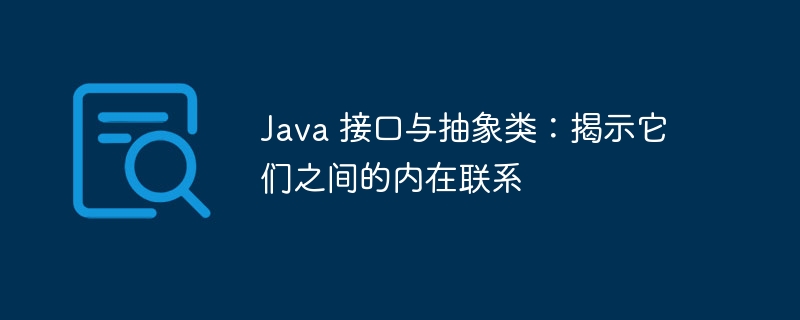Home >Java >javaTutorial >Java interfaces and abstract classes: revealing the inner connection between them
Java interfaces and abstract classes: revealing the inner connection between them
- 王林forward
- 2024-03-04 09:34:06638browse

Java interface and abstract class are two design concepts commonly used in object-oriented programming. They are closely related but have their own characteristics. In actual development, understanding the similarities and differences between them is crucial to writing high-quality code. This article will deeply explore the intrinsic relationship between Java interfaces and abstract classes to help readers better understand and apply these two design patterns. Let us uncover their mysteries together!
Interfaces define abstract methods and constants in Java. The methods in the interface are not implemented, but are provided by the class that implements the interface. The interface defines a contract that requires the implementation class to provide specified method implementations.
Declare interface:
public interface ExampleInterface {
void doSomething();
int getSomething();
}
Abstract class
Abstract class is a class that cannot be instantiated. It contains a mixture of abstract and non-abstract methods. Similar to interfaces, abstract methods in abstract classes are implemented by subclasses. However, abstract classes can also contain concrete methods, which provide default implementations.
Declare abstract class:
public abstract class ExampleAbstractClass {
abstract void doSomething();
int getSomething() {
return 0;
}
}
inner relationship:
There is the following intrinsic relationship between interfaces and abstract classes:
- Abstractness: Both define abstract methods, which are implemented by concrete classes.
- Polymorphism: Classes that implement the same interface or extend the same abstract class can use polymorphism, and they can be used interchangeably.
- Interfaces can inherit from abstract classes: Interfaces can inherit methods from abstract classes, and abstract classes will serve as the implementation classes of the interface.
the difference:
Despite the connection, there are still the following differences between interfaces and abstract classes:
- Implementation: Interfaces can only define abstract methods, while abstract classes can provide implementation of specific methods.
- Multiple inheritance: A class can implement multiple interfaces, but can only inherit one abstract class.
- Instantiation: Interfaces cannot be instantiated, while abstract classes can be instantiated (but usually not).
Best Practices:
When deciding to use an interface or an abstract class, consider the following best practices:
-
Use interface if:
- You need to define a behavioral contract without specifying an implementation.
- You need to support multiple inheritance.
- You want to keep your code loosely coupled.
-
Use abstract class if:
- You need to provide a default implementation of the abstract method.
- You need to use restricted inheritance, where subclasses can only inherit from one class.
- You need to access the instance variables of the parent class.
in conclusion:
Interfaces and abstract classes in Java are abstract data types, providing a framework for abstract methods and implementations. The two are intrinsically linked, but they also have different roles and best practices. Understanding their differences and connections is crucial to using them effectively in Java programs. By choosing interfaces or abstract classes wisely, you can create maintainable, extensible, and reusable code.
The above is the detailed content of Java interfaces and abstract classes: revealing the inner connection between them. For more information, please follow other related articles on the PHP Chinese website!
Related articles
See more- Detailed explanation of interfaces, abstract classes and the differences between interfaces and abstract classes in PHP
- The difference between java abstract class and interface
- What are the positive and negative poles of the usb interface wiring diagram?
- What are abstract data types?
- How to solve javac is not an internal or external command, nor is it an operable program?

